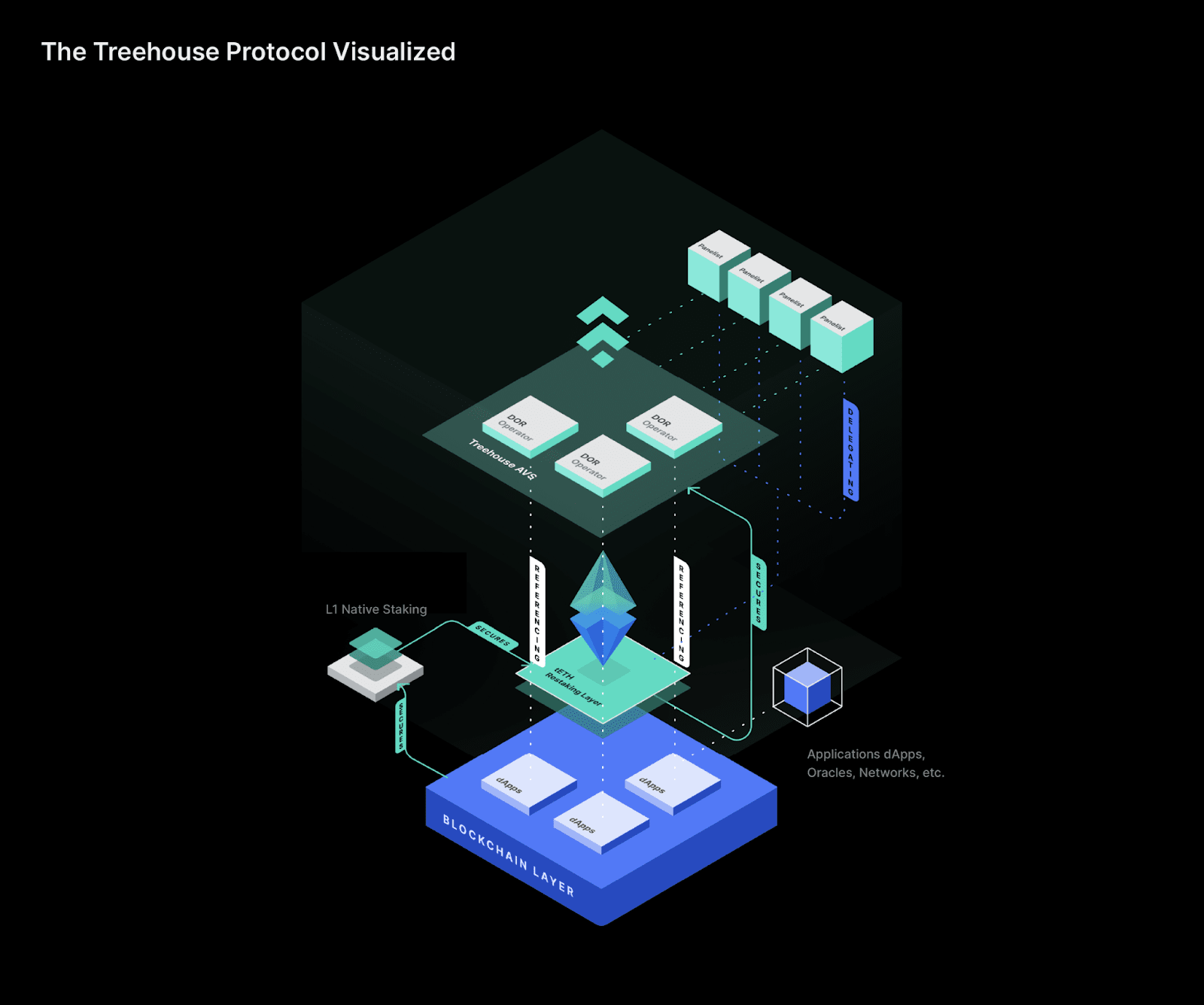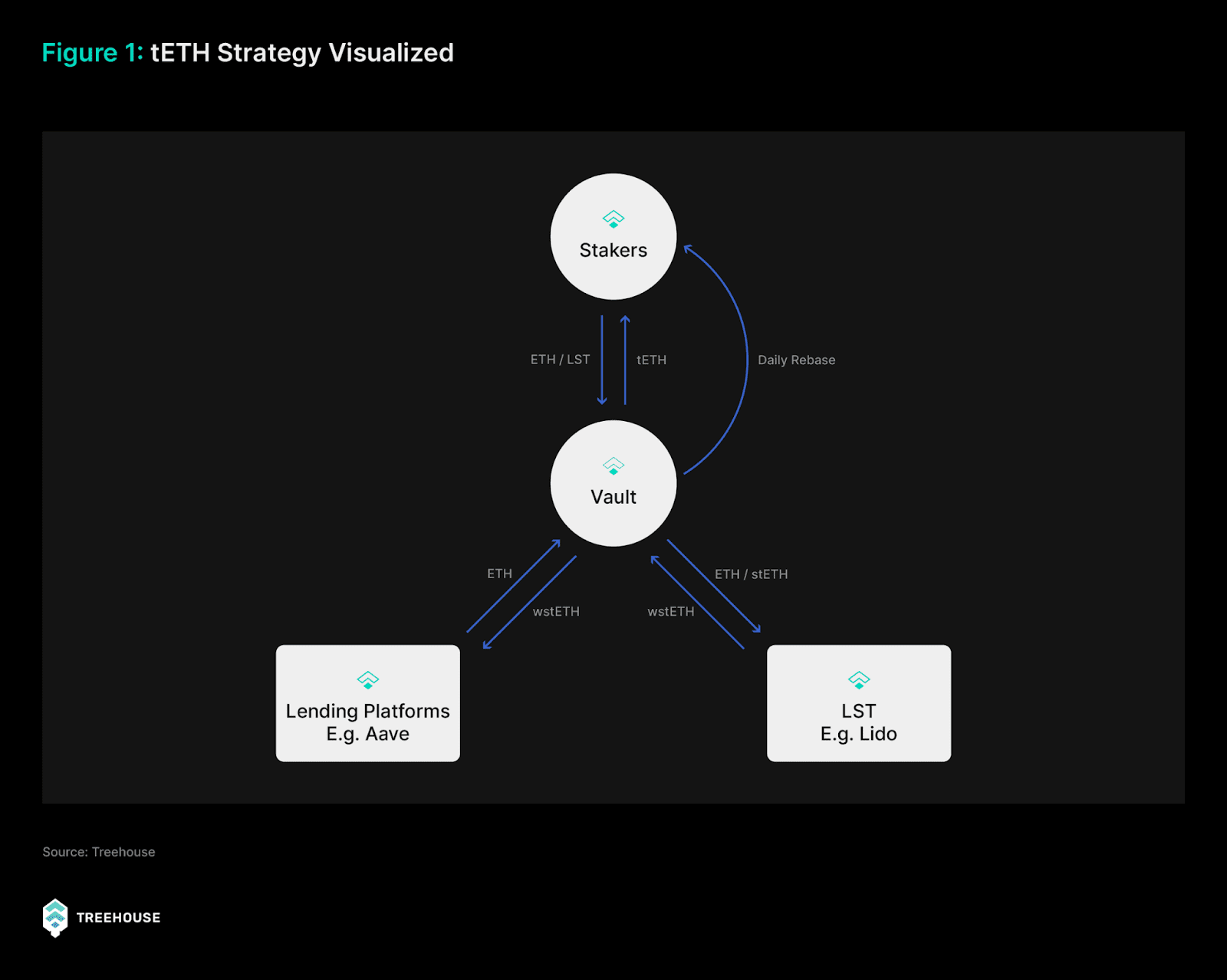Treehouse is a dApp built to simplify the process of earning fixed yields in the DeFi ecosystem. Instead of requiring users to manually search for and compare lending protocols or providing liquidity, Treehouse operates as a smart aggregator.
This means that the platform automatically collects data from various protocols, standardizes information about interest rates and participation conditions, and then analyzes and selects optimal strategies to allocate users' assets.
As a result, users can receive a more effective, stable fixed interest rate without needing to understand the complex mechanisms behind it or constantly monitor the market.
What problem does Treehouse solve?
In the current DeFi landscape, staking interest rates are fragmented - each platform like Lido, Rocket Pool pays different yields. This makes it difficult for investors and on-chain financial applications to build fixed interest rate products.
Thus, Treehouse positions itself as a DeFi protocol as a 'Decentralized Fixed Income Layer', addressing the issue by aggregating yield and using DOR (Decentralized Offered Rates) to establish an interest rate benchmark for DeFi.

Treehouse Products
With the combination of blockchain technology and traditional financial thinking, Treehouse builds a user-friendly product ecosystem.
tAssets – Integrated yield, simplified for users
tETH is a liquid staking product developed by Treehouse to optimize yields for users from ETH. When users deposit ETH or staking tokens like stETH, wstETH, they will receive tETH (representing their contributed assets).
Treehouse not only stakes simply, but also applies a strategy of using LST (Liquid Staking Token) as collateral to borrow ETH, then continues to stake the borrowed ETH.
Thus, users can receive additional yields from the interest rate differentials between protocols - known as arbitrage yield. In addition to the base staking yield, tETH also accumulates income from borrowing activities and participating in reward campaigns.

The yield for tETH holders is represented through an index called MEY (Market Effective Yield) - the actual yield you receive after the protocol has executed optimal strategies. MEY changes daily and is publicly and transparently updated. Thus, users can enjoy interest rates that are often higher than direct staking, without needing to monitor or adjust anything.
Specific formula: tETH = LST + Market Efficiency Yield + Points
To protect individuals, the project implements risk management through mechanisms:
Profitability Assessment & Utilization Rate: The protocol monitors the utilization rate of borrowed ETH; if it exceeds the safety threshold (for example, >89% for 2 consecutive days), the system will unwind to reduce ETH usage, protecting sustainability. When the staking strategy for the loan is overloaded, surplus assets are automatically allocated to the highest yield strategy.
Protocol-Owned Peg Protection (PPP): if tETH loses its peg (the price is lower than wstETH), the Treehouse team will use the 'Insurance Fund' to buy back and rebalance the price, protecting users from de-peg fluctuations. Profits from this process are shared with tETH holders, liquidity pools, and the treasury protocol.
Users can swap tETH for wstETH through liquidity pools like Curve if the amount is small. For larger withdrawals, the process requires burning tETH and waiting for the system to process it for about 7 days. Additionally, there is a quick withdrawal option called Fastlane Redemption, allowing immediate receipt of wstETH but with a fee of about 2%.
DOR - The First Decentralized Interest Rate for DeFi
In the traditional financial world, when banks need to borrow from each other, they often refer to benchmark interest rates such as LIBOR (London Interbank Offered Rate) or SOFR (Secured Overnight Financing Rate). In relation, DOR is the reference interest rate of DeFi, created to measure the cost of capital usage in the cryptocurrency market. It acts like an 'anchor' for users and DeFi protocols to rely on when pricing financial products such as lending, interest rate swaps, fixed contracts, etc.
Treehouse's DOR index operates based on the coordination between three main roles: Panelist, Operator, and Delegator.
In which, Panelists are experts responsible for collecting and submitting actual interest rate data from the DeFi market into the system. To support this process, Operators manage the technical infrastructure, ensuring that the data is sent accurately and on time.
Delegators are regular users who do not directly submit data but can stake TREE to support the panelists they trust, thereby sharing rewards while also bearing the risk if the panelists act non-transparently. Subsequently, Treehouse aggregates this data and calculates a median level, which is the interest rate in the middle, not overly affected by outlier values. Each asset will have a DOR index.
Vaults - Automating DeFi Strategies
Treehouse develops two smart Vaults to help users optimize yields from ETH without deep technical knowledge: tETH Vault and gtETH Vault.
With tETH Vault, users deposit ETH and receive tETH - representing staked ETH that automatically uses leverage to generate higher yields than traditional staking.
Meanwhile, the gtETH Vault is an advanced version applying in-depth strategies such as leveraging arbitrage opportunities between markets; optimizing loans based on actual interest rate situations in DeFi; extracting profits from MEV (Miner Extractable Value) - the benefits that transaction executors can obtain from ordering transactions in a block.
These strategies are often complex and require in-depth risk management, so the gtETH Vault does not operate entirely automatically like the tETH Vault, but has strategy management from trusted Treehouse partners.
GoNuts Season 1 Campaign
Treehouse has launched a community campaign to thank early users ahead of the listing on Binance on July 29, 2025. This campaign is designed to encourage genuine and long-term participation and is also a common marketing method seen in the Crypto market.
Users can accumulate Nuts (on-chain reward points) by holding tAssets like tETH, participating in vaults, staking events, or through referrals. Qualifying wallets need to hold a minimum of 100 Nuts before May 29, 2025, to receive airdrop token TREE. Additionally, Treehouse also releases the Squirrel Council NFT (only 1,001 available) to double the amount of Nuts received - while unlocking benefits within the Treehouse ecosystem.
Notably, Treehouse is also the 29th project in the Binance HODLer Airdrop program, allocating 12.5 million TREE to BNB stakers on Binance from July 10 to 13.
What is the Treehouse Token?
Token Name: Treehouse
Ticker: TREE
Blockchain: Ethereum
Token Standard: ERC‑20
Token Type: Governance & Utility
Total Supply: 1,000,000,000 TREE
TREE Token Allocation
The TREE token is allocated as follows:
Community Rewards: 20%
Strategic Investors: 17.5%
Team: 12.5%
Treasury Fund: 12.5%
Community Airdrop: 10%
Future Airdrops: 5.75%
Core Contributors: 5%
Exchange Partnerships: 3.75%
Development Team & Investors
Founding & Development Team
Brandon Goh (Co-founder & CEO): A graduate of the University of Chicago, Brandon previously worked at J.P. Morgan in finance and strategy. He brings a solid background in traditional finance and sharp operational thinking.
Bryan Goh (Co-founder): A graduate of Cornell University, with experience at MassMutual in quantitative investing and financial technology. He combines technical understanding with investment strategy.
Kang Loh (Co-founder): A former student of the National University of Singapore (NUS), Kang previously held product management and engineering roles at technology companies in the region.
Treehouse gathers a team of blockchain engineers, quantitative experts, and experienced DeFi analysts from leading organizations like Polkadot, MassMutual, Citadel, Goldman Sachs… Most have studied and worked at top universities worldwide like MIT, Stanford, LSE, with strengths in finance, software engineering, and blockchain.
